MKT3125 Service Marketing: EFQM Model Analysis of Squire Hotel
VerifiedAdded on 2023/04/20
|12
|4390
|395
Report
AI Summary
This business report analyzes the Squire Hotel group, focusing on applying the EFQM model to address key challenges such as low occupancy rates, customer complaints about food quality, and competition from rival establishments. The report begins with an introduction to the EFQM model, explaining its fundamental concepts of excellence, including creating a sustainable future, adding value for customers, developing organizational capability, and leading with vision and integrity. The report then details the criteria of the EFQM model, differentiating between enablers (leadership, people, strategy, partnerships and resources, processes, products, and services) and results (people, customer, society, and business results). The RADAR logic is also explained as a tool for performance assessment. The report reviews successful organizations that have used the EFQM model, providing a framework for applying the model to the Squire Hotel to identify weaknesses and suggest improvements in areas such as service quality and customer satisfaction. The report then concludes with recommendations based on the EFQM model analysis, aiming to improve the hotel's overall performance and competitiveness.
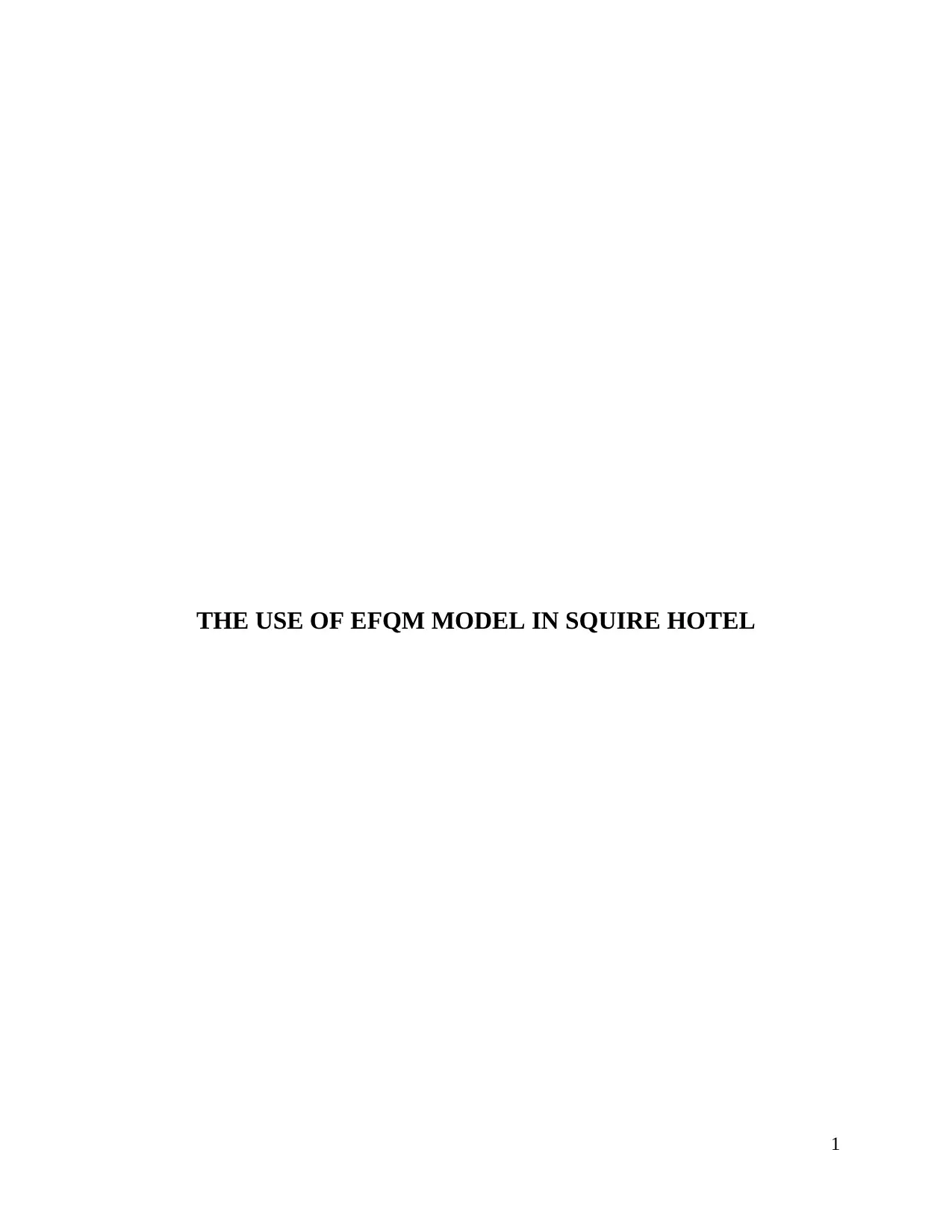
THE USE OF EFQM MODEL IN SQUIRE HOTEL
1
1
Paraphrase This Document
Need a fresh take? Get an instant paraphrase of this document with our AI Paraphraser

Table of Contents
Introduction......................................................................................................................................3
The background information about the Squire Hotel group............................................................3
SHG issues...................................................................................................................................3
Measuring performance by using the EFQM model.......................................................................4
The fundamental concepts of excellence.....................................................................................4
Criteria of the model....................................................................................................................5
RADAR logic..............................................................................................................................6
Limitations of using the EFQM model............................................................................................6
Examples of using the EFQM model by successful organizations..................................................7
Pom+ consulting, Switzerland.....................................................................................................7
Cross country, UK.......................................................................................................................7
Alpenresort Schwarz, Austria......................................................................................................7
Application of EFQM model to the Squire hotel.............................................................................7
Conclusion.......................................................................................................................................8
Recommendation.............................................................................................................................8
References......................................................................................................................................10
2
Introduction......................................................................................................................................3
The background information about the Squire Hotel group............................................................3
SHG issues...................................................................................................................................3
Measuring performance by using the EFQM model.......................................................................4
The fundamental concepts of excellence.....................................................................................4
Criteria of the model....................................................................................................................5
RADAR logic..............................................................................................................................6
Limitations of using the EFQM model............................................................................................6
Examples of using the EFQM model by successful organizations..................................................7
Pom+ consulting, Switzerland.....................................................................................................7
Cross country, UK.......................................................................................................................7
Alpenresort Schwarz, Austria......................................................................................................7
Application of EFQM model to the Squire hotel.............................................................................7
Conclusion.......................................................................................................................................8
Recommendation.............................................................................................................................8
References......................................................................................................................................10
2
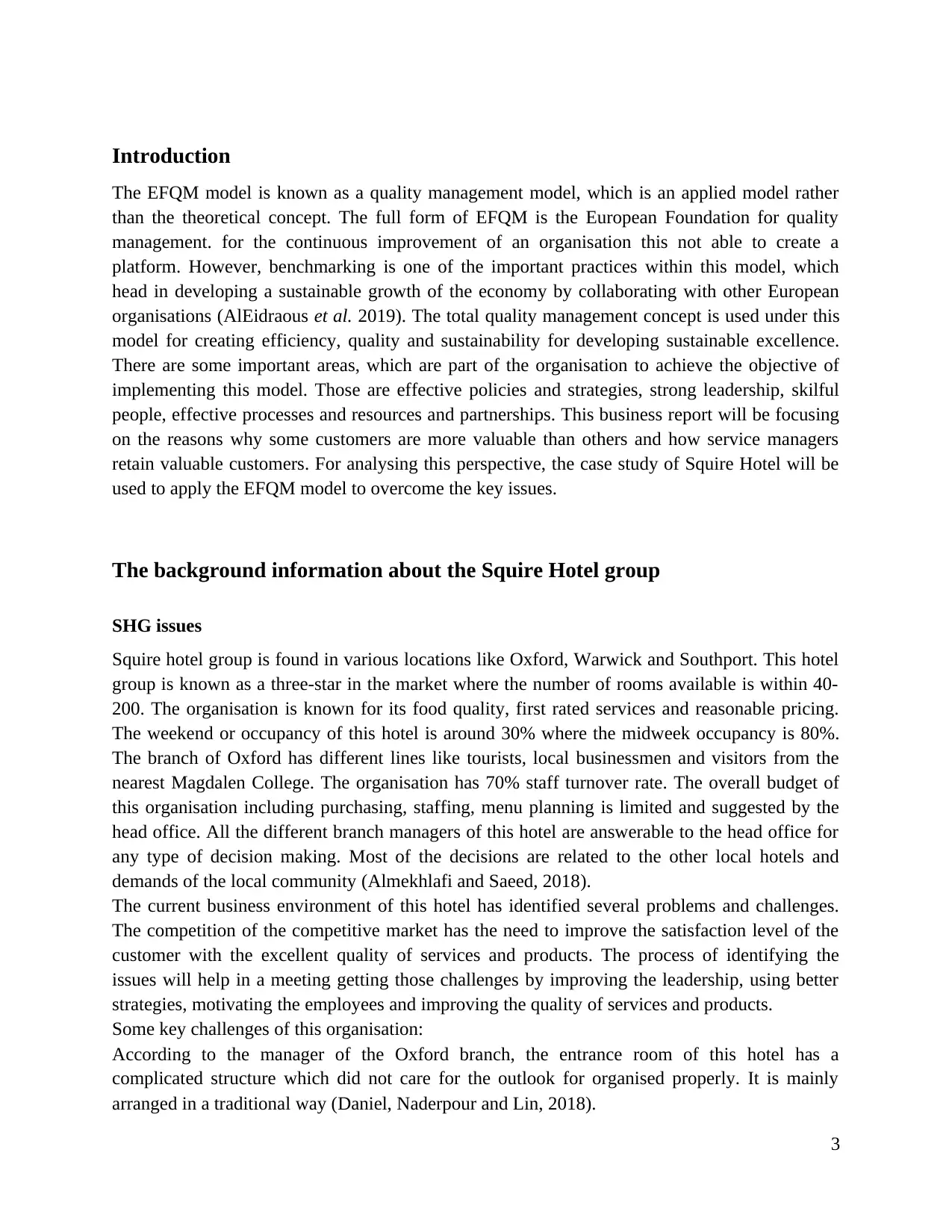
Introduction
The EFQM model is known as a quality management model, which is an applied model rather
than the theoretical concept. The full form of EFQM is the European Foundation for quality
management. for the continuous improvement of an organisation this not able to create a
platform. However, benchmarking is one of the important practices within this model, which
head in developing a sustainable growth of the economy by collaborating with other European
organisations (AlEidraous et al. 2019). The total quality management concept is used under this
model for creating efficiency, quality and sustainability for developing sustainable excellence.
There are some important areas, which are part of the organisation to achieve the objective of
implementing this model. Those are effective policies and strategies, strong leadership, skilful
people, effective processes and resources and partnerships. This business report will be focusing
on the reasons why some customers are more valuable than others and how service managers
retain valuable customers. For analysing this perspective, the case study of Squire Hotel will be
used to apply the EFQM model to overcome the key issues.
The background information about the Squire Hotel group
SHG issues
Squire hotel group is found in various locations like Oxford, Warwick and Southport. This hotel
group is known as a three-star in the market where the number of rooms available is within 40-
200. The organisation is known for its food quality, first rated services and reasonable pricing.
The weekend or occupancy of this hotel is around 30% where the midweek occupancy is 80%.
The branch of Oxford has different lines like tourists, local businessmen and visitors from the
nearest Magdalen College. The organisation has 70% staff turnover rate. The overall budget of
this organisation including purchasing, staffing, menu planning is limited and suggested by the
head office. All the different branch managers of this hotel are answerable to the head office for
any type of decision making. Most of the decisions are related to the other local hotels and
demands of the local community (Almekhlafi and Saeed, 2018).
The current business environment of this hotel has identified several problems and challenges.
The competition of the competitive market has the need to improve the satisfaction level of the
customer with the excellent quality of services and products. The process of identifying the
issues will help in a meeting getting those challenges by improving the leadership, using better
strategies, motivating the employees and improving the quality of services and products.
Some key challenges of this organisation:
According to the manager of the Oxford branch, the entrance room of this hotel has a
complicated structure which did not care for the outlook for organised properly. It is mainly
arranged in a traditional way (Daniel, Naderpour and Lin, 2018).
3
The EFQM model is known as a quality management model, which is an applied model rather
than the theoretical concept. The full form of EFQM is the European Foundation for quality
management. for the continuous improvement of an organisation this not able to create a
platform. However, benchmarking is one of the important practices within this model, which
head in developing a sustainable growth of the economy by collaborating with other European
organisations (AlEidraous et al. 2019). The total quality management concept is used under this
model for creating efficiency, quality and sustainability for developing sustainable excellence.
There are some important areas, which are part of the organisation to achieve the objective of
implementing this model. Those are effective policies and strategies, strong leadership, skilful
people, effective processes and resources and partnerships. This business report will be focusing
on the reasons why some customers are more valuable than others and how service managers
retain valuable customers. For analysing this perspective, the case study of Squire Hotel will be
used to apply the EFQM model to overcome the key issues.
The background information about the Squire Hotel group
SHG issues
Squire hotel group is found in various locations like Oxford, Warwick and Southport. This hotel
group is known as a three-star in the market where the number of rooms available is within 40-
200. The organisation is known for its food quality, first rated services and reasonable pricing.
The weekend or occupancy of this hotel is around 30% where the midweek occupancy is 80%.
The branch of Oxford has different lines like tourists, local businessmen and visitors from the
nearest Magdalen College. The organisation has 70% staff turnover rate. The overall budget of
this organisation including purchasing, staffing, menu planning is limited and suggested by the
head office. All the different branch managers of this hotel are answerable to the head office for
any type of decision making. Most of the decisions are related to the other local hotels and
demands of the local community (Almekhlafi and Saeed, 2018).
The current business environment of this hotel has identified several problems and challenges.
The competition of the competitive market has the need to improve the satisfaction level of the
customer with the excellent quality of services and products. The process of identifying the
issues will help in a meeting getting those challenges by improving the leadership, using better
strategies, motivating the employees and improving the quality of services and products.
Some key challenges of this organisation:
According to the manager of the Oxford branch, the entrance room of this hotel has a
complicated structure which did not care for the outlook for organised properly. It is mainly
arranged in a traditional way (Daniel, Naderpour and Lin, 2018).
3
⊘ This is a preview!⊘
Do you want full access?
Subscribe today to unlock all pages.

Trusted by 1+ million students worldwide
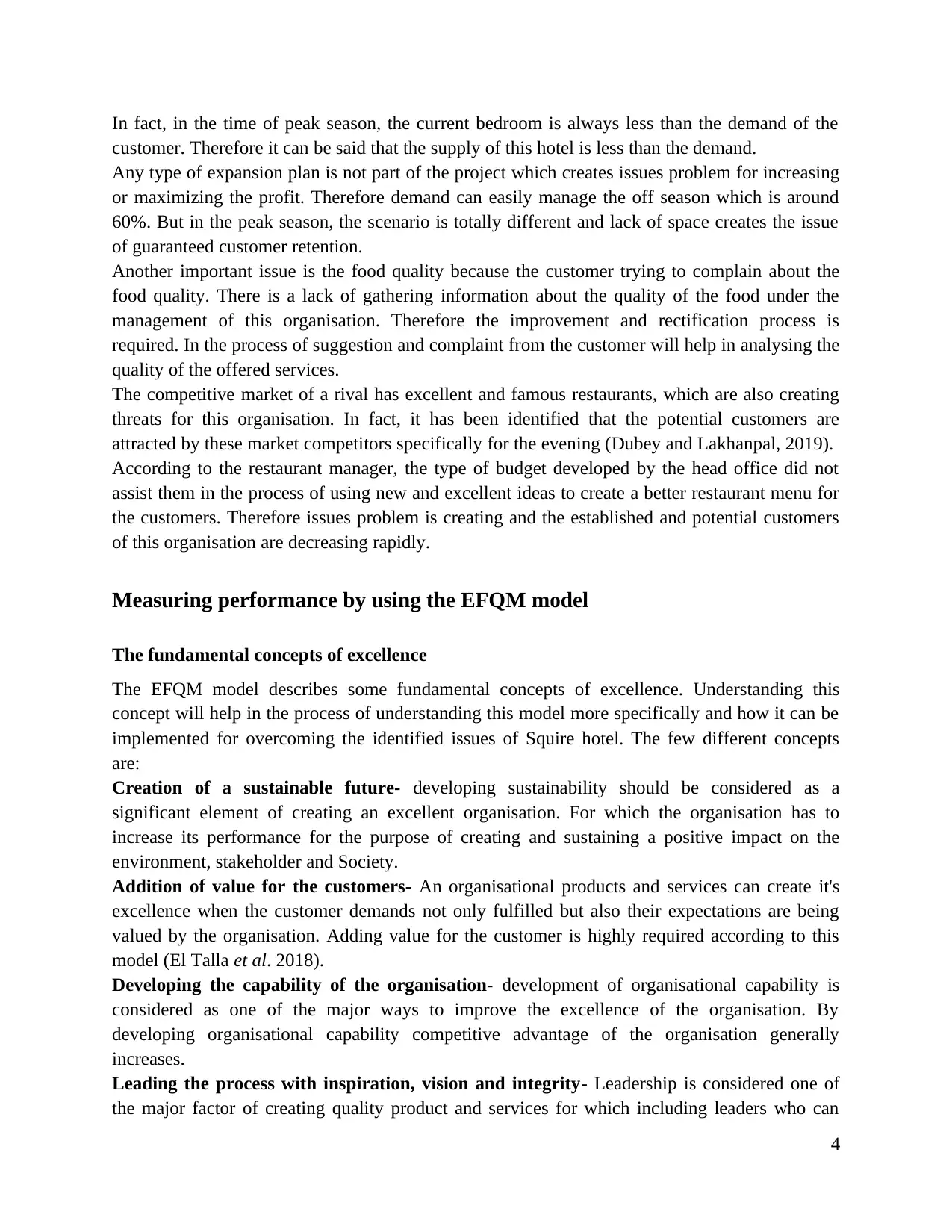
In fact, in the time of peak season, the current bedroom is always less than the demand of the
customer. Therefore it can be said that the supply of this hotel is less than the demand.
Any type of expansion plan is not part of the project which creates issues problem for increasing
or maximizing the profit. Therefore demand can easily manage the off season which is around
60%. But in the peak season, the scenario is totally different and lack of space creates the issue
of guaranteed customer retention.
Another important issue is the food quality because the customer trying to complain about the
food quality. There is a lack of gathering information about the quality of the food under the
management of this organisation. Therefore the improvement and rectification process is
required. In the process of suggestion and complaint from the customer will help in analysing the
quality of the offered services.
The competitive market of a rival has excellent and famous restaurants, which are also creating
threats for this organisation. In fact, it has been identified that the potential customers are
attracted by these market competitors specifically for the evening (Dubey and Lakhanpal, 2019).
According to the restaurant manager, the type of budget developed by the head office did not
assist them in the process of using new and excellent ideas to create a better restaurant menu for
the customers. Therefore issues problem is creating and the established and potential customers
of this organisation are decreasing rapidly.
Measuring performance by using the EFQM model
The fundamental concepts of excellence
The EFQM model describes some fundamental concepts of excellence. Understanding this
concept will help in the process of understanding this model more specifically and how it can be
implemented for overcoming the identified issues of Squire hotel. The few different concepts
are:
Creation of a sustainable future- developing sustainability should be considered as a
significant element of creating an excellent organisation. For which the organisation has to
increase its performance for the purpose of creating and sustaining a positive impact on the
environment, stakeholder and Society.
Addition of value for the customers- An organisational products and services can create it's
excellence when the customer demands not only fulfilled but also their expectations are being
valued by the organisation. Adding value for the customer is highly required according to this
model (El Talla et al. 2018).
Developing the capability of the organisation- development of organisational capability is
considered as one of the major ways to improve the excellence of the organisation. By
developing organisational capability competitive advantage of the organisation generally
increases.
Leading the process with inspiration, vision and integrity- Leadership is considered one of
the major factor of creating quality product and services for which including leaders who can
4
customer. Therefore it can be said that the supply of this hotel is less than the demand.
Any type of expansion plan is not part of the project which creates issues problem for increasing
or maximizing the profit. Therefore demand can easily manage the off season which is around
60%. But in the peak season, the scenario is totally different and lack of space creates the issue
of guaranteed customer retention.
Another important issue is the food quality because the customer trying to complain about the
food quality. There is a lack of gathering information about the quality of the food under the
management of this organisation. Therefore the improvement and rectification process is
required. In the process of suggestion and complaint from the customer will help in analysing the
quality of the offered services.
The competitive market of a rival has excellent and famous restaurants, which are also creating
threats for this organisation. In fact, it has been identified that the potential customers are
attracted by these market competitors specifically for the evening (Dubey and Lakhanpal, 2019).
According to the restaurant manager, the type of budget developed by the head office did not
assist them in the process of using new and excellent ideas to create a better restaurant menu for
the customers. Therefore issues problem is creating and the established and potential customers
of this organisation are decreasing rapidly.
Measuring performance by using the EFQM model
The fundamental concepts of excellence
The EFQM model describes some fundamental concepts of excellence. Understanding this
concept will help in the process of understanding this model more specifically and how it can be
implemented for overcoming the identified issues of Squire hotel. The few different concepts
are:
Creation of a sustainable future- developing sustainability should be considered as a
significant element of creating an excellent organisation. For which the organisation has to
increase its performance for the purpose of creating and sustaining a positive impact on the
environment, stakeholder and Society.
Addition of value for the customers- An organisational products and services can create it's
excellence when the customer demands not only fulfilled but also their expectations are being
valued by the organisation. Adding value for the customer is highly required according to this
model (El Talla et al. 2018).
Developing the capability of the organisation- development of organisational capability is
considered as one of the major ways to improve the excellence of the organisation. By
developing organisational capability competitive advantage of the organisation generally
increases.
Leading the process with inspiration, vision and integrity- Leadership is considered one of
the major factor of creating quality product and services for which including leaders who can
4
Paraphrase This Document
Need a fresh take? Get an instant paraphrase of this document with our AI Paraphraser
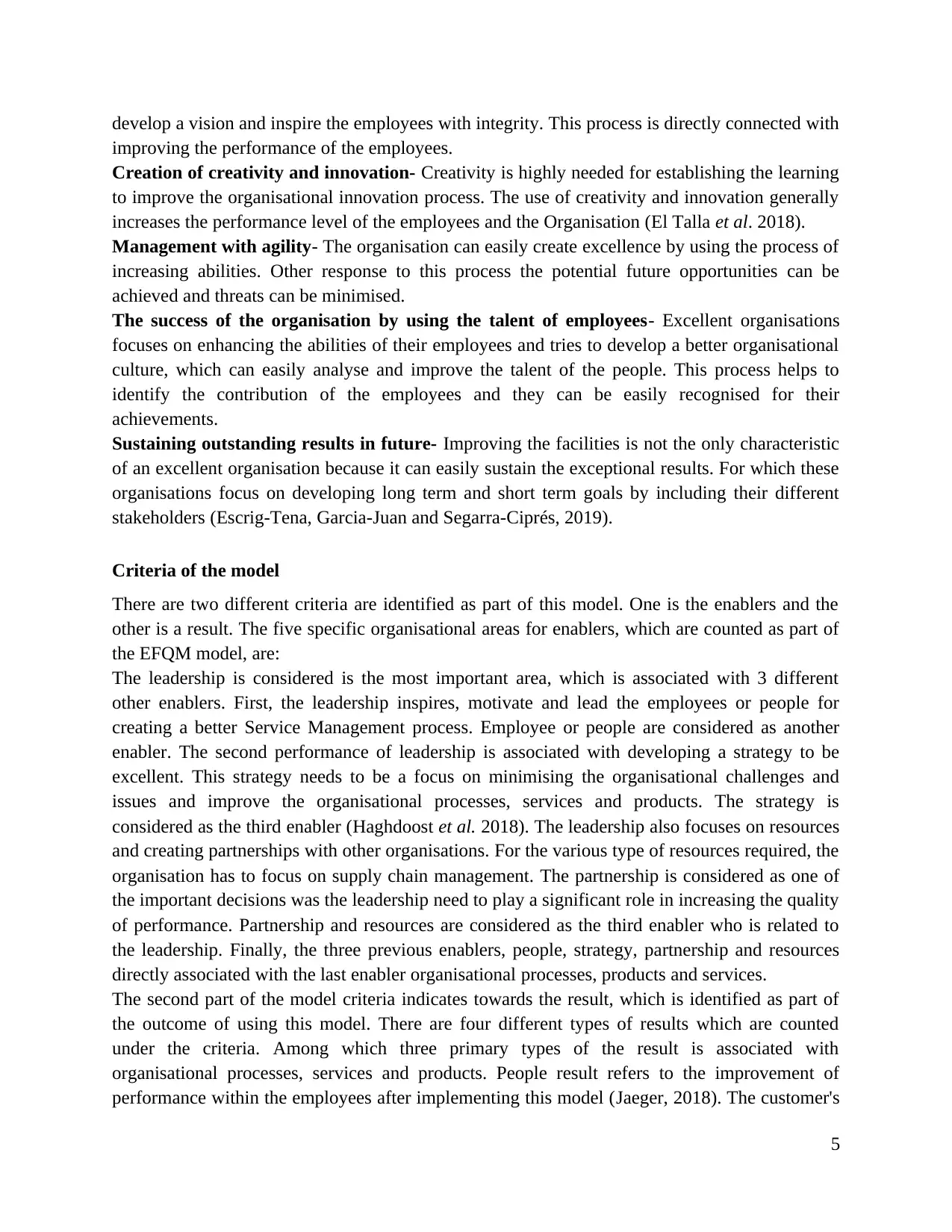
develop a vision and inspire the employees with integrity. This process is directly connected with
improving the performance of the employees.
Creation of creativity and innovation- Creativity is highly needed for establishing the learning
to improve the organisational innovation process. The use of creativity and innovation generally
increases the performance level of the employees and the Organisation (El Talla et al. 2018).
Management with agility- The organisation can easily create excellence by using the process of
increasing abilities. Other response to this process the potential future opportunities can be
achieved and threats can be minimised.
The success of the organisation by using the talent of employees- Excellent organisations
focuses on enhancing the abilities of their employees and tries to develop a better organisational
culture, which can easily analyse and improve the talent of the people. This process helps to
identify the contribution of the employees and they can be easily recognised for their
achievements.
Sustaining outstanding results in future- Improving the facilities is not the only characteristic
of an excellent organisation because it can easily sustain the exceptional results. For which these
organisations focus on developing long term and short term goals by including their different
stakeholders (Escrig-Tena, Garcia-Juan and Segarra-Ciprés, 2019).
Criteria of the model
There are two different criteria are identified as part of this model. One is the enablers and the
other is a result. The five specific organisational areas for enablers, which are counted as part of
the EFQM model, are:
The leadership is considered is the most important area, which is associated with 3 different
other enablers. First, the leadership inspires, motivate and lead the employees or people for
creating a better Service Management process. Employee or people are considered as another
enabler. The second performance of leadership is associated with developing a strategy to be
excellent. This strategy needs to be a focus on minimising the organisational challenges and
issues and improve the organisational processes, services and products. The strategy is
considered as the third enabler (Haghdoost et al. 2018). The leadership also focuses on resources
and creating partnerships with other organisations. For the various type of resources required, the
organisation has to focus on supply chain management. The partnership is considered as one of
the important decisions was the leadership need to play a significant role in increasing the quality
of performance. Partnership and resources are considered as the third enabler who is related to
the leadership. Finally, the three previous enablers, people, strategy, partnership and resources
directly associated with the last enabler organisational processes, products and services.
The second part of the model criteria indicates towards the result, which is identified as part of
the outcome of using this model. There are four different types of results which are counted
under the criteria. Among which three primary types of the result is associated with
organisational processes, services and products. People result refers to the improvement of
performance within the employees after implementing this model (Jaeger, 2018). The customer's
5
improving the performance of the employees.
Creation of creativity and innovation- Creativity is highly needed for establishing the learning
to improve the organisational innovation process. The use of creativity and innovation generally
increases the performance level of the employees and the Organisation (El Talla et al. 2018).
Management with agility- The organisation can easily create excellence by using the process of
increasing abilities. Other response to this process the potential future opportunities can be
achieved and threats can be minimised.
The success of the organisation by using the talent of employees- Excellent organisations
focuses on enhancing the abilities of their employees and tries to develop a better organisational
culture, which can easily analyse and improve the talent of the people. This process helps to
identify the contribution of the employees and they can be easily recognised for their
achievements.
Sustaining outstanding results in future- Improving the facilities is not the only characteristic
of an excellent organisation because it can easily sustain the exceptional results. For which these
organisations focus on developing long term and short term goals by including their different
stakeholders (Escrig-Tena, Garcia-Juan and Segarra-Ciprés, 2019).
Criteria of the model
There are two different criteria are identified as part of this model. One is the enablers and the
other is a result. The five specific organisational areas for enablers, which are counted as part of
the EFQM model, are:
The leadership is considered is the most important area, which is associated with 3 different
other enablers. First, the leadership inspires, motivate and lead the employees or people for
creating a better Service Management process. Employee or people are considered as another
enabler. The second performance of leadership is associated with developing a strategy to be
excellent. This strategy needs to be a focus on minimising the organisational challenges and
issues and improve the organisational processes, services and products. The strategy is
considered as the third enabler (Haghdoost et al. 2018). The leadership also focuses on resources
and creating partnerships with other organisations. For the various type of resources required, the
organisation has to focus on supply chain management. The partnership is considered as one of
the important decisions was the leadership need to play a significant role in increasing the quality
of performance. Partnership and resources are considered as the third enabler who is related to
the leadership. Finally, the three previous enablers, people, strategy, partnership and resources
directly associated with the last enabler organisational processes, products and services.
The second part of the model criteria indicates towards the result, which is identified as part of
the outcome of using this model. There are four different types of results which are counted
under the criteria. Among which three primary types of the result is associated with
organisational processes, services and products. People result refers to the improvement of
performance within the employees after implementing this model (Jaeger, 2018). The customer's
5
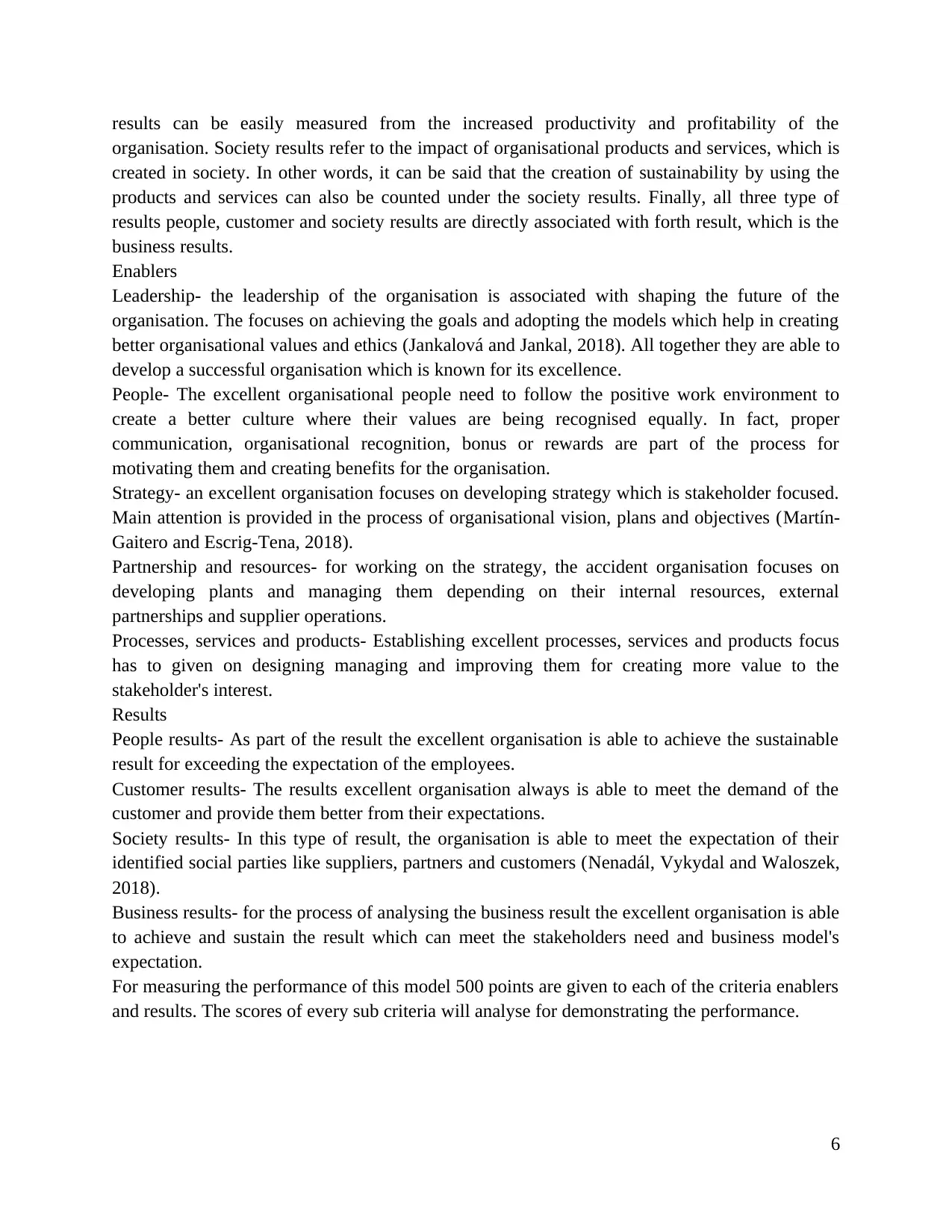
results can be easily measured from the increased productivity and profitability of the
organisation. Society results refer to the impact of organisational products and services, which is
created in society. In other words, it can be said that the creation of sustainability by using the
products and services can also be counted under the society results. Finally, all three type of
results people, customer and society results are directly associated with forth result, which is the
business results.
Enablers
Leadership- the leadership of the organisation is associated with shaping the future of the
organisation. The focuses on achieving the goals and adopting the models which help in creating
better organisational values and ethics (Jankalová and Jankal, 2018). All together they are able to
develop a successful organisation which is known for its excellence.
People- The excellent organisational people need to follow the positive work environment to
create a better culture where their values are being recognised equally. In fact, proper
communication, organisational recognition, bonus or rewards are part of the process for
motivating them and creating benefits for the organisation.
Strategy- an excellent organisation focuses on developing strategy which is stakeholder focused.
Main attention is provided in the process of organisational vision, plans and objectives (Martín-
Gaitero and Escrig-Tena, 2018).
Partnership and resources- for working on the strategy, the accident organisation focuses on
developing plants and managing them depending on their internal resources, external
partnerships and supplier operations.
Processes, services and products- Establishing excellent processes, services and products focus
has to given on designing managing and improving them for creating more value to the
stakeholder's interest.
Results
People results- As part of the result the excellent organisation is able to achieve the sustainable
result for exceeding the expectation of the employees.
Customer results- The results excellent organisation always is able to meet the demand of the
customer and provide them better from their expectations.
Society results- In this type of result, the organisation is able to meet the expectation of their
identified social parties like suppliers, partners and customers (Nenadál, Vykydal and Waloszek,
2018).
Business results- for the process of analysing the business result the excellent organisation is able
to achieve and sustain the result which can meet the stakeholders need and business model's
expectation.
For measuring the performance of this model 500 points are given to each of the criteria enablers
and results. The scores of every sub criteria will analyse for demonstrating the performance.
6
organisation. Society results refer to the impact of organisational products and services, which is
created in society. In other words, it can be said that the creation of sustainability by using the
products and services can also be counted under the society results. Finally, all three type of
results people, customer and society results are directly associated with forth result, which is the
business results.
Enablers
Leadership- the leadership of the organisation is associated with shaping the future of the
organisation. The focuses on achieving the goals and adopting the models which help in creating
better organisational values and ethics (Jankalová and Jankal, 2018). All together they are able to
develop a successful organisation which is known for its excellence.
People- The excellent organisational people need to follow the positive work environment to
create a better culture where their values are being recognised equally. In fact, proper
communication, organisational recognition, bonus or rewards are part of the process for
motivating them and creating benefits for the organisation.
Strategy- an excellent organisation focuses on developing strategy which is stakeholder focused.
Main attention is provided in the process of organisational vision, plans and objectives (Martín-
Gaitero and Escrig-Tena, 2018).
Partnership and resources- for working on the strategy, the accident organisation focuses on
developing plants and managing them depending on their internal resources, external
partnerships and supplier operations.
Processes, services and products- Establishing excellent processes, services and products focus
has to given on designing managing and improving them for creating more value to the
stakeholder's interest.
Results
People results- As part of the result the excellent organisation is able to achieve the sustainable
result for exceeding the expectation of the employees.
Customer results- The results excellent organisation always is able to meet the demand of the
customer and provide them better from their expectations.
Society results- In this type of result, the organisation is able to meet the expectation of their
identified social parties like suppliers, partners and customers (Nenadál, Vykydal and Waloszek,
2018).
Business results- for the process of analysing the business result the excellent organisation is able
to achieve and sustain the result which can meet the stakeholders need and business model's
expectation.
For measuring the performance of this model 500 points are given to each of the criteria enablers
and results. The scores of every sub criteria will analyse for demonstrating the performance.
6
⊘ This is a preview!⊘
Do you want full access?
Subscribe today to unlock all pages.

Trusted by 1+ million students worldwide
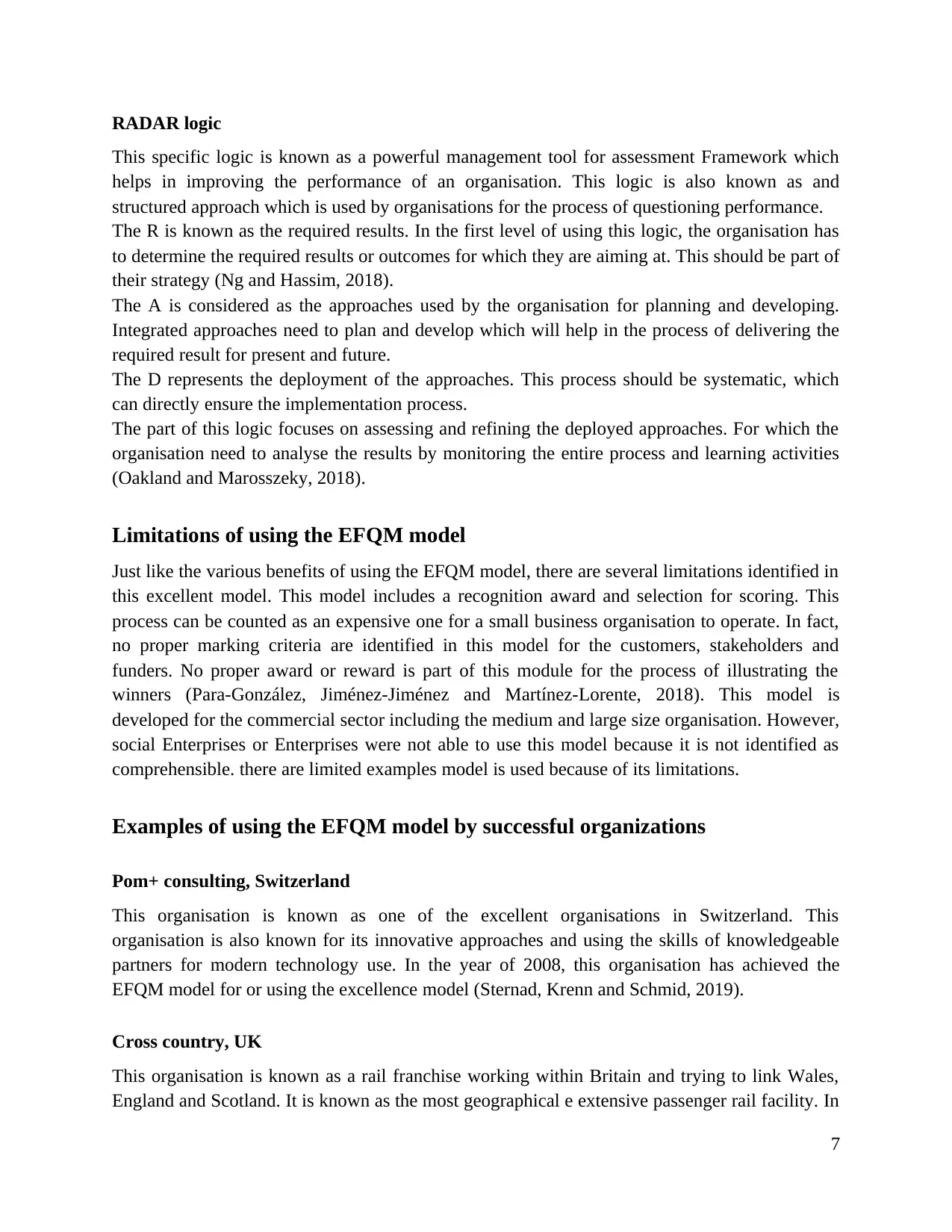
RADAR logic
This specific logic is known as a powerful management tool for assessment Framework which
helps in improving the performance of an organisation. This logic is also known as and
structured approach which is used by organisations for the process of questioning performance.
The R is known as the required results. In the first level of using this logic, the organisation has
to determine the required results or outcomes for which they are aiming at. This should be part of
their strategy (Ng and Hassim, 2018).
The A is considered as the approaches used by the organisation for planning and developing.
Integrated approaches need to plan and develop which will help in the process of delivering the
required result for present and future.
The D represents the deployment of the approaches. This process should be systematic, which
can directly ensure the implementation process.
The part of this logic focuses on assessing and refining the deployed approaches. For which the
organisation need to analyse the results by monitoring the entire process and learning activities
(Oakland and Marosszeky, 2018).
Limitations of using the EFQM model
Just like the various benefits of using the EFQM model, there are several limitations identified in
this excellent model. This model includes a recognition award and selection for scoring. This
process can be counted as an expensive one for a small business organisation to operate. In fact,
no proper marking criteria are identified in this model for the customers, stakeholders and
funders. No proper award or reward is part of this module for the process of illustrating the
winners (Para-González, Jiménez-Jiménez and Martínez-Lorente, 2018). This model is
developed for the commercial sector including the medium and large size organisation. However,
social Enterprises or Enterprises were not able to use this model because it is not identified as
comprehensible. there are limited examples model is used because of its limitations.
Examples of using the EFQM model by successful organizations
Pom+ consulting, Switzerland
This organisation is known as one of the excellent organisations in Switzerland. This
organisation is also known for its innovative approaches and using the skills of knowledgeable
partners for modern technology use. In the year of 2008, this organisation has achieved the
EFQM model for or using the excellence model (Sternad, Krenn and Schmid, 2019).
Cross country, UK
This organisation is known as a rail franchise working within Britain and trying to link Wales,
England and Scotland. It is known as the most geographical e extensive passenger rail facility. In
7
This specific logic is known as a powerful management tool for assessment Framework which
helps in improving the performance of an organisation. This logic is also known as and
structured approach which is used by organisations for the process of questioning performance.
The R is known as the required results. In the first level of using this logic, the organisation has
to determine the required results or outcomes for which they are aiming at. This should be part of
their strategy (Ng and Hassim, 2018).
The A is considered as the approaches used by the organisation for planning and developing.
Integrated approaches need to plan and develop which will help in the process of delivering the
required result for present and future.
The D represents the deployment of the approaches. This process should be systematic, which
can directly ensure the implementation process.
The part of this logic focuses on assessing and refining the deployed approaches. For which the
organisation need to analyse the results by monitoring the entire process and learning activities
(Oakland and Marosszeky, 2018).
Limitations of using the EFQM model
Just like the various benefits of using the EFQM model, there are several limitations identified in
this excellent model. This model includes a recognition award and selection for scoring. This
process can be counted as an expensive one for a small business organisation to operate. In fact,
no proper marking criteria are identified in this model for the customers, stakeholders and
funders. No proper award or reward is part of this module for the process of illustrating the
winners (Para-González, Jiménez-Jiménez and Martínez-Lorente, 2018). This model is
developed for the commercial sector including the medium and large size organisation. However,
social Enterprises or Enterprises were not able to use this model because it is not identified as
comprehensible. there are limited examples model is used because of its limitations.
Examples of using the EFQM model by successful organizations
Pom+ consulting, Switzerland
This organisation is known as one of the excellent organisations in Switzerland. This
organisation is also known for its innovative approaches and using the skills of knowledgeable
partners for modern technology use. In the year of 2008, this organisation has achieved the
EFQM model for or using the excellence model (Sternad, Krenn and Schmid, 2019).
Cross country, UK
This organisation is known as a rail franchise working within Britain and trying to link Wales,
England and Scotland. It is known as the most geographical e extensive passenger rail facility. In
7
Paraphrase This Document
Need a fresh take? Get an instant paraphrase of this document with our AI Paraphraser
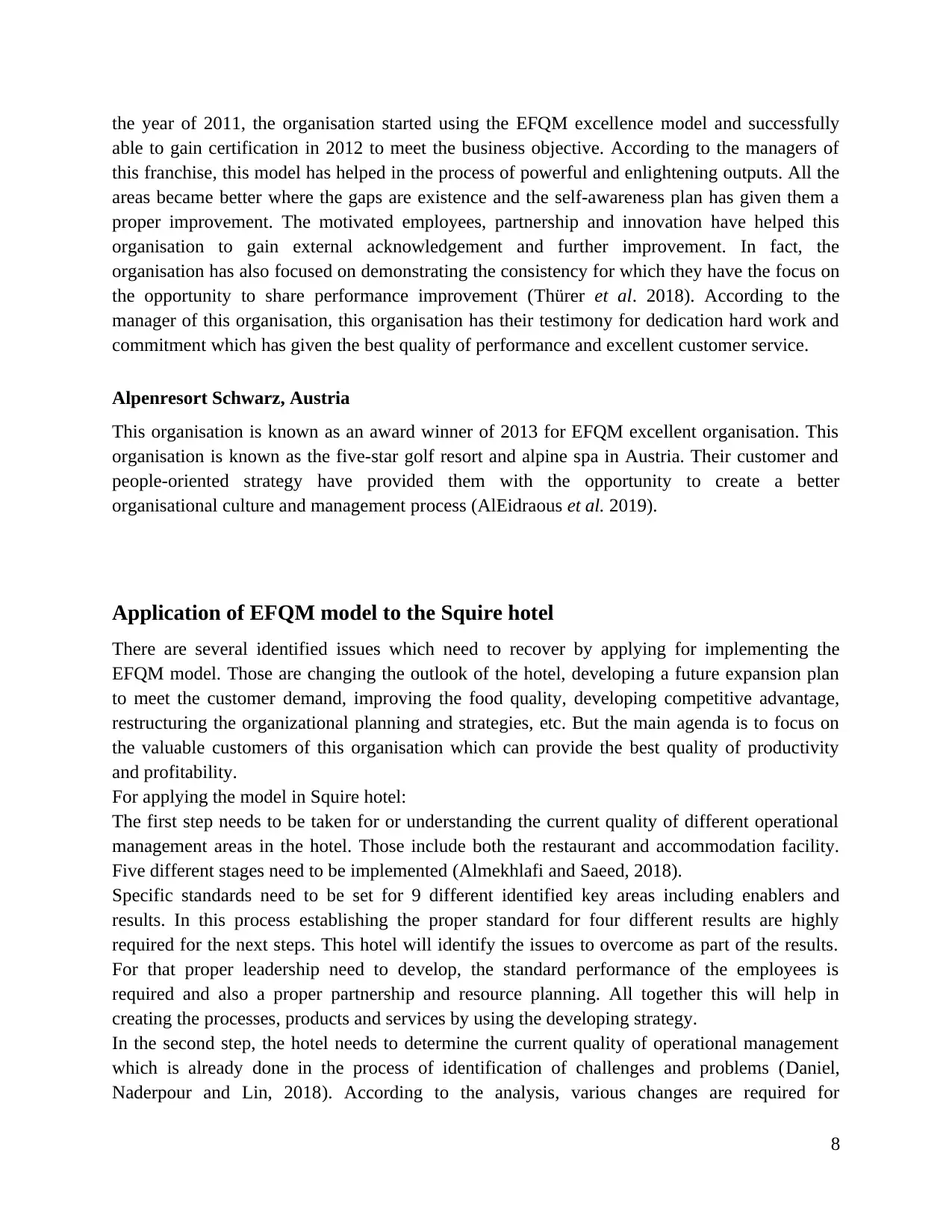
the year of 2011, the organisation started using the EFQM excellence model and successfully
able to gain certification in 2012 to meet the business objective. According to the managers of
this franchise, this model has helped in the process of powerful and enlightening outputs. All the
areas became better where the gaps are existence and the self-awareness plan has given them a
proper improvement. The motivated employees, partnership and innovation have helped this
organisation to gain external acknowledgement and further improvement. In fact, the
organisation has also focused on demonstrating the consistency for which they have the focus on
the opportunity to share performance improvement (Thürer et al. 2018). According to the
manager of this organisation, this organisation has their testimony for dedication hard work and
commitment which has given the best quality of performance and excellent customer service.
Alpenresort Schwarz, Austria
This organisation is known as an award winner of 2013 for EFQM excellent organisation. This
organisation is known as the five-star golf resort and alpine spa in Austria. Their customer and
people-oriented strategy have provided them with the opportunity to create a better
organisational culture and management process (AlEidraous et al. 2019).
Application of EFQM model to the Squire hotel
There are several identified issues which need to recover by applying for implementing the
EFQM model. Those are changing the outlook of the hotel, developing a future expansion plan
to meet the customer demand, improving the food quality, developing competitive advantage,
restructuring the organizational planning and strategies, etc. But the main agenda is to focus on
the valuable customers of this organisation which can provide the best quality of productivity
and profitability.
For applying the model in Squire hotel:
The first step needs to be taken for or understanding the current quality of different operational
management areas in the hotel. Those include both the restaurant and accommodation facility.
Five different stages need to be implemented (Almekhlafi and Saeed, 2018).
Specific standards need to be set for 9 different identified key areas including enablers and
results. In this process establishing the proper standard for four different results are highly
required for the next steps. This hotel will identify the issues to overcome as part of the results.
For that proper leadership need to develop, the standard performance of the employees is
required and also a proper partnership and resource planning. All together this will help in
creating the processes, products and services by using the developing strategy.
In the second step, the hotel needs to determine the current quality of operational management
which is already done in the process of identification of challenges and problems (Daniel,
Naderpour and Lin, 2018). According to the analysis, various changes are required for
8
able to gain certification in 2012 to meet the business objective. According to the managers of
this franchise, this model has helped in the process of powerful and enlightening outputs. All the
areas became better where the gaps are existence and the self-awareness plan has given them a
proper improvement. The motivated employees, partnership and innovation have helped this
organisation to gain external acknowledgement and further improvement. In fact, the
organisation has also focused on demonstrating the consistency for which they have the focus on
the opportunity to share performance improvement (Thürer et al. 2018). According to the
manager of this organisation, this organisation has their testimony for dedication hard work and
commitment which has given the best quality of performance and excellent customer service.
Alpenresort Schwarz, Austria
This organisation is known as an award winner of 2013 for EFQM excellent organisation. This
organisation is known as the five-star golf resort and alpine spa in Austria. Their customer and
people-oriented strategy have provided them with the opportunity to create a better
organisational culture and management process (AlEidraous et al. 2019).
Application of EFQM model to the Squire hotel
There are several identified issues which need to recover by applying for implementing the
EFQM model. Those are changing the outlook of the hotel, developing a future expansion plan
to meet the customer demand, improving the food quality, developing competitive advantage,
restructuring the organizational planning and strategies, etc. But the main agenda is to focus on
the valuable customers of this organisation which can provide the best quality of productivity
and profitability.
For applying the model in Squire hotel:
The first step needs to be taken for or understanding the current quality of different operational
management areas in the hotel. Those include both the restaurant and accommodation facility.
Five different stages need to be implemented (Almekhlafi and Saeed, 2018).
Specific standards need to be set for 9 different identified key areas including enablers and
results. In this process establishing the proper standard for four different results are highly
required for the next steps. This hotel will identify the issues to overcome as part of the results.
For that proper leadership need to develop, the standard performance of the employees is
required and also a proper partnership and resource planning. All together this will help in
creating the processes, products and services by using the developing strategy.
In the second step, the hotel needs to determine the current quality of operational management
which is already done in the process of identification of challenges and problems (Daniel,
Naderpour and Lin, 2018). According to the analysis, various changes are required for
8
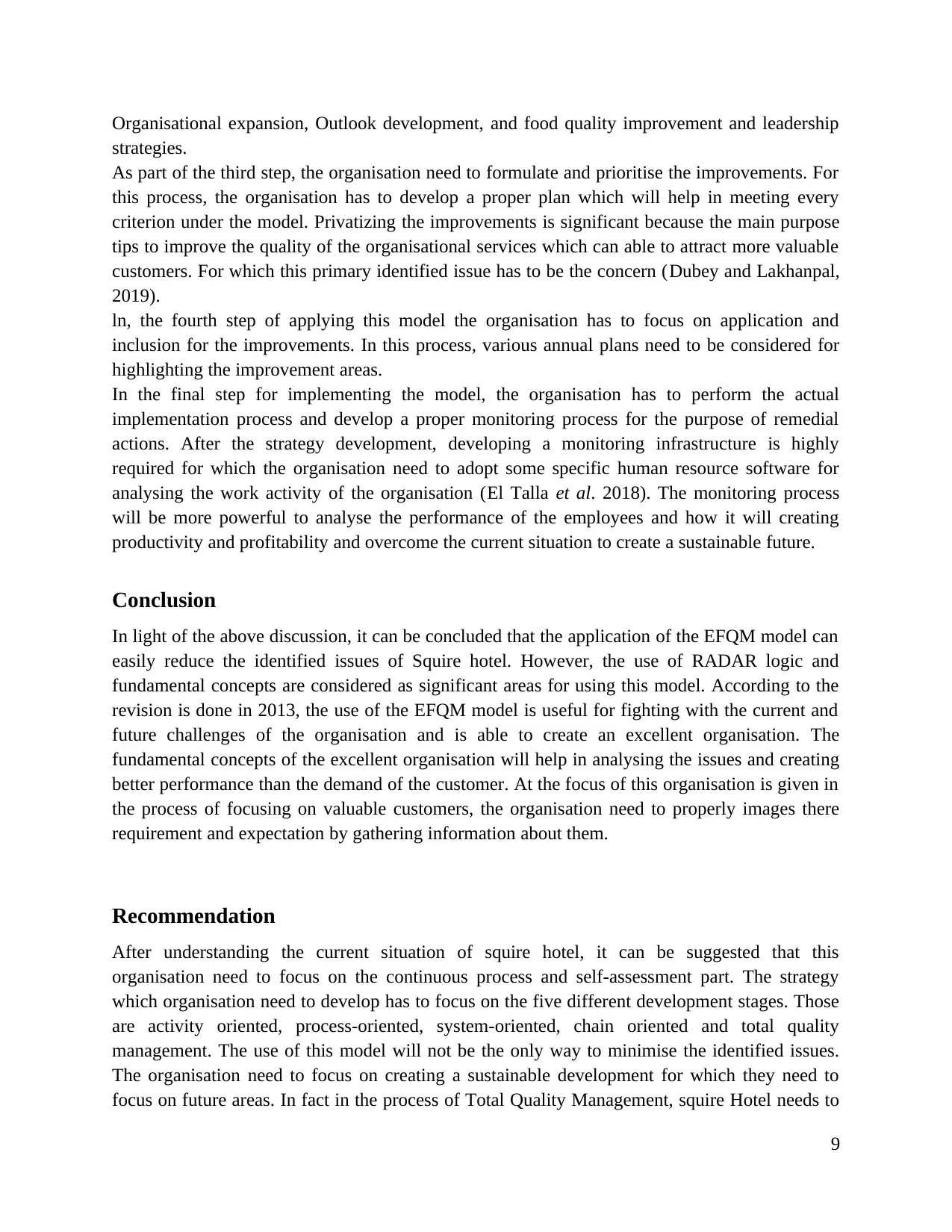
Organisational expansion, Outlook development, and food quality improvement and leadership
strategies.
As part of the third step, the organisation need to formulate and prioritise the improvements. For
this process, the organisation has to develop a proper plan which will help in meeting every
criterion under the model. Privatizing the improvements is significant because the main purpose
tips to improve the quality of the organisational services which can able to attract more valuable
customers. For which this primary identified issue has to be the concern (Dubey and Lakhanpal,
2019).
ln, the fourth step of applying this model the organisation has to focus on application and
inclusion for the improvements. In this process, various annual plans need to be considered for
highlighting the improvement areas.
In the final step for implementing the model, the organisation has to perform the actual
implementation process and develop a proper monitoring process for the purpose of remedial
actions. After the strategy development, developing a monitoring infrastructure is highly
required for which the organisation need to adopt some specific human resource software for
analysing the work activity of the organisation (El Talla et al. 2018). The monitoring process
will be more powerful to analyse the performance of the employees and how it will creating
productivity and profitability and overcome the current situation to create a sustainable future.
Conclusion
In light of the above discussion, it can be concluded that the application of the EFQM model can
easily reduce the identified issues of Squire hotel. However, the use of RADAR logic and
fundamental concepts are considered as significant areas for using this model. According to the
revision is done in 2013, the use of the EFQM model is useful for fighting with the current and
future challenges of the organisation and is able to create an excellent organisation. The
fundamental concepts of the excellent organisation will help in analysing the issues and creating
better performance than the demand of the customer. At the focus of this organisation is given in
the process of focusing on valuable customers, the organisation need to properly images there
requirement and expectation by gathering information about them.
Recommendation
After understanding the current situation of squire hotel, it can be suggested that this
organisation need to focus on the continuous process and self-assessment part. The strategy
which organisation need to develop has to focus on the five different development stages. Those
are activity oriented, process-oriented, system-oriented, chain oriented and total quality
management. The use of this model will not be the only way to minimise the identified issues.
The organisation need to focus on creating a sustainable development for which they need to
focus on future areas. In fact in the process of Total Quality Management, squire Hotel needs to
9
strategies.
As part of the third step, the organisation need to formulate and prioritise the improvements. For
this process, the organisation has to develop a proper plan which will help in meeting every
criterion under the model. Privatizing the improvements is significant because the main purpose
tips to improve the quality of the organisational services which can able to attract more valuable
customers. For which this primary identified issue has to be the concern (Dubey and Lakhanpal,
2019).
ln, the fourth step of applying this model the organisation has to focus on application and
inclusion for the improvements. In this process, various annual plans need to be considered for
highlighting the improvement areas.
In the final step for implementing the model, the organisation has to perform the actual
implementation process and develop a proper monitoring process for the purpose of remedial
actions. After the strategy development, developing a monitoring infrastructure is highly
required for which the organisation need to adopt some specific human resource software for
analysing the work activity of the organisation (El Talla et al. 2018). The monitoring process
will be more powerful to analyse the performance of the employees and how it will creating
productivity and profitability and overcome the current situation to create a sustainable future.
Conclusion
In light of the above discussion, it can be concluded that the application of the EFQM model can
easily reduce the identified issues of Squire hotel. However, the use of RADAR logic and
fundamental concepts are considered as significant areas for using this model. According to the
revision is done in 2013, the use of the EFQM model is useful for fighting with the current and
future challenges of the organisation and is able to create an excellent organisation. The
fundamental concepts of the excellent organisation will help in analysing the issues and creating
better performance than the demand of the customer. At the focus of this organisation is given in
the process of focusing on valuable customers, the organisation need to properly images there
requirement and expectation by gathering information about them.
Recommendation
After understanding the current situation of squire hotel, it can be suggested that this
organisation need to focus on the continuous process and self-assessment part. The strategy
which organisation need to develop has to focus on the five different development stages. Those
are activity oriented, process-oriented, system-oriented, chain oriented and total quality
management. The use of this model will not be the only way to minimise the identified issues.
The organisation need to focus on creating a sustainable development for which they need to
focus on future areas. In fact in the process of Total Quality Management, squire Hotel needs to
9
⊘ This is a preview!⊘
Do you want full access?
Subscribe today to unlock all pages.

Trusted by 1+ million students worldwide
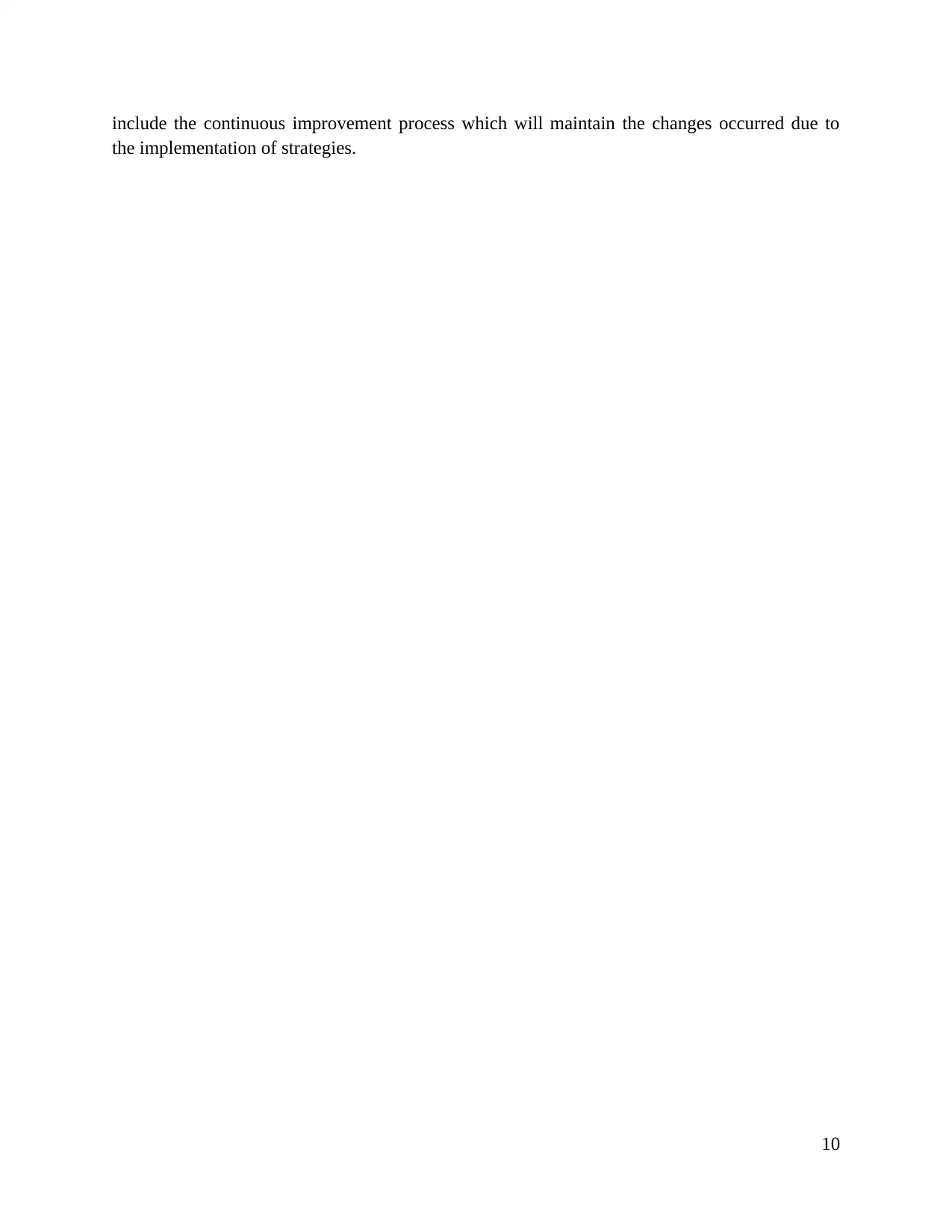
include the continuous improvement process which will maintain the changes occurred due to
the implementation of strategies.
10
the implementation of strategies.
10
Paraphrase This Document
Need a fresh take? Get an instant paraphrase of this document with our AI Paraphraser
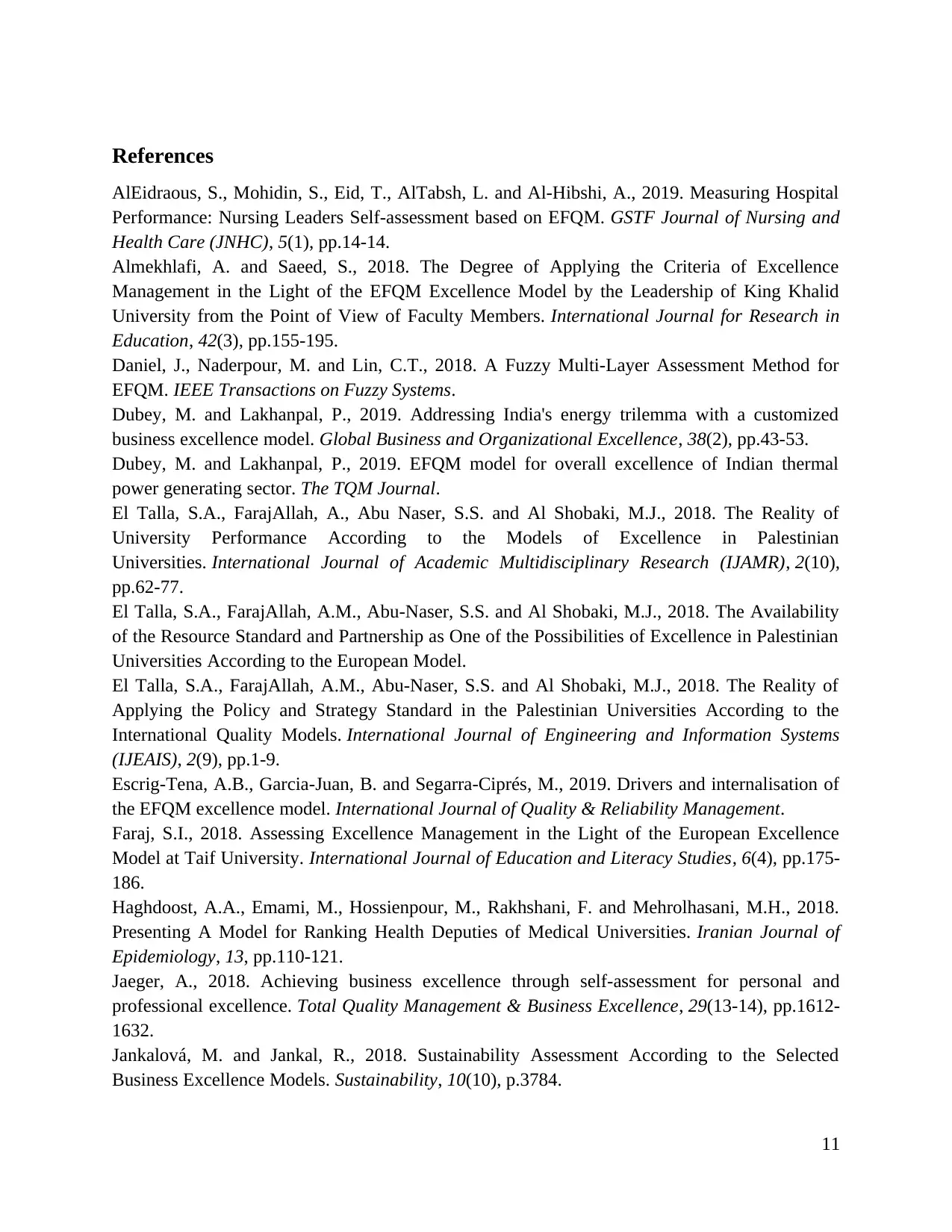
References
AlEidraous, S., Mohidin, S., Eid, T., AlTabsh, L. and Al-Hibshi, A., 2019. Measuring Hospital
Performance: Nursing Leaders Self-assessment based on EFQM. GSTF Journal of Nursing and
Health Care (JNHC), 5(1), pp.14-14.
Almekhlafi, A. and Saeed, S., 2018. The Degree of Applying the Criteria of Excellence
Management in the Light of the EFQM Excellence Model by the Leadership of King Khalid
University from the Point of View of Faculty Members. International Journal for Research in
Education, 42(3), pp.155-195.
Daniel, J., Naderpour, M. and Lin, C.T., 2018. A Fuzzy Multi-Layer Assessment Method for
EFQM. IEEE Transactions on Fuzzy Systems.
Dubey, M. and Lakhanpal, P., 2019. Addressing India's energy trilemma with a customized
business excellence model. Global Business and Organizational Excellence, 38(2), pp.43-53.
Dubey, M. and Lakhanpal, P., 2019. EFQM model for overall excellence of Indian thermal
power generating sector. The TQM Journal.
El Talla, S.A., FarajAllah, A., Abu Naser, S.S. and Al Shobaki, M.J., 2018. The Reality of
University Performance According to the Models of Excellence in Palestinian
Universities. International Journal of Academic Multidisciplinary Research (IJAMR), 2(10),
pp.62-77.
El Talla, S.A., FarajAllah, A.M., Abu-Naser, S.S. and Al Shobaki, M.J., 2018. The Availability
of the Resource Standard and Partnership as One of the Possibilities of Excellence in Palestinian
Universities According to the European Model.
El Talla, S.A., FarajAllah, A.M., Abu-Naser, S.S. and Al Shobaki, M.J., 2018. The Reality of
Applying the Policy and Strategy Standard in the Palestinian Universities According to the
International Quality Models. International Journal of Engineering and Information Systems
(IJEAIS), 2(9), pp.1-9.
Escrig-Tena, A.B., Garcia-Juan, B. and Segarra-Ciprés, M., 2019. Drivers and internalisation of
the EFQM excellence model. International Journal of Quality & Reliability Management.
Faraj, S.I., 2018. Assessing Excellence Management in the Light of the European Excellence
Model at Taif University. International Journal of Education and Literacy Studies, 6(4), pp.175-
186.
Haghdoost, A.A., Emami, M., Hossienpour, M., Rakhshani, F. and Mehrolhasani, M.H., 2018.
Presenting A Model for Ranking Health Deputies of Medical Universities. Iranian Journal of
Epidemiology, 13, pp.110-121.
Jaeger, A., 2018. Achieving business excellence through self-assessment for personal and
professional excellence. Total Quality Management & Business Excellence, 29(13-14), pp.1612-
1632.
Jankalová, M. and Jankal, R., 2018. Sustainability Assessment According to the Selected
Business Excellence Models. Sustainability, 10(10), p.3784.
11
AlEidraous, S., Mohidin, S., Eid, T., AlTabsh, L. and Al-Hibshi, A., 2019. Measuring Hospital
Performance: Nursing Leaders Self-assessment based on EFQM. GSTF Journal of Nursing and
Health Care (JNHC), 5(1), pp.14-14.
Almekhlafi, A. and Saeed, S., 2018. The Degree of Applying the Criteria of Excellence
Management in the Light of the EFQM Excellence Model by the Leadership of King Khalid
University from the Point of View of Faculty Members. International Journal for Research in
Education, 42(3), pp.155-195.
Daniel, J., Naderpour, M. and Lin, C.T., 2018. A Fuzzy Multi-Layer Assessment Method for
EFQM. IEEE Transactions on Fuzzy Systems.
Dubey, M. and Lakhanpal, P., 2019. Addressing India's energy trilemma with a customized
business excellence model. Global Business and Organizational Excellence, 38(2), pp.43-53.
Dubey, M. and Lakhanpal, P., 2019. EFQM model for overall excellence of Indian thermal
power generating sector. The TQM Journal.
El Talla, S.A., FarajAllah, A., Abu Naser, S.S. and Al Shobaki, M.J., 2018. The Reality of
University Performance According to the Models of Excellence in Palestinian
Universities. International Journal of Academic Multidisciplinary Research (IJAMR), 2(10),
pp.62-77.
El Talla, S.A., FarajAllah, A.M., Abu-Naser, S.S. and Al Shobaki, M.J., 2018. The Availability
of the Resource Standard and Partnership as One of the Possibilities of Excellence in Palestinian
Universities According to the European Model.
El Talla, S.A., FarajAllah, A.M., Abu-Naser, S.S. and Al Shobaki, M.J., 2018. The Reality of
Applying the Policy and Strategy Standard in the Palestinian Universities According to the
International Quality Models. International Journal of Engineering and Information Systems
(IJEAIS), 2(9), pp.1-9.
Escrig-Tena, A.B., Garcia-Juan, B. and Segarra-Ciprés, M., 2019. Drivers and internalisation of
the EFQM excellence model. International Journal of Quality & Reliability Management.
Faraj, S.I., 2018. Assessing Excellence Management in the Light of the European Excellence
Model at Taif University. International Journal of Education and Literacy Studies, 6(4), pp.175-
186.
Haghdoost, A.A., Emami, M., Hossienpour, M., Rakhshani, F. and Mehrolhasani, M.H., 2018.
Presenting A Model for Ranking Health Deputies of Medical Universities. Iranian Journal of
Epidemiology, 13, pp.110-121.
Jaeger, A., 2018. Achieving business excellence through self-assessment for personal and
professional excellence. Total Quality Management & Business Excellence, 29(13-14), pp.1612-
1632.
Jankalová, M. and Jankal, R., 2018. Sustainability Assessment According to the Selected
Business Excellence Models. Sustainability, 10(10), p.3784.
11
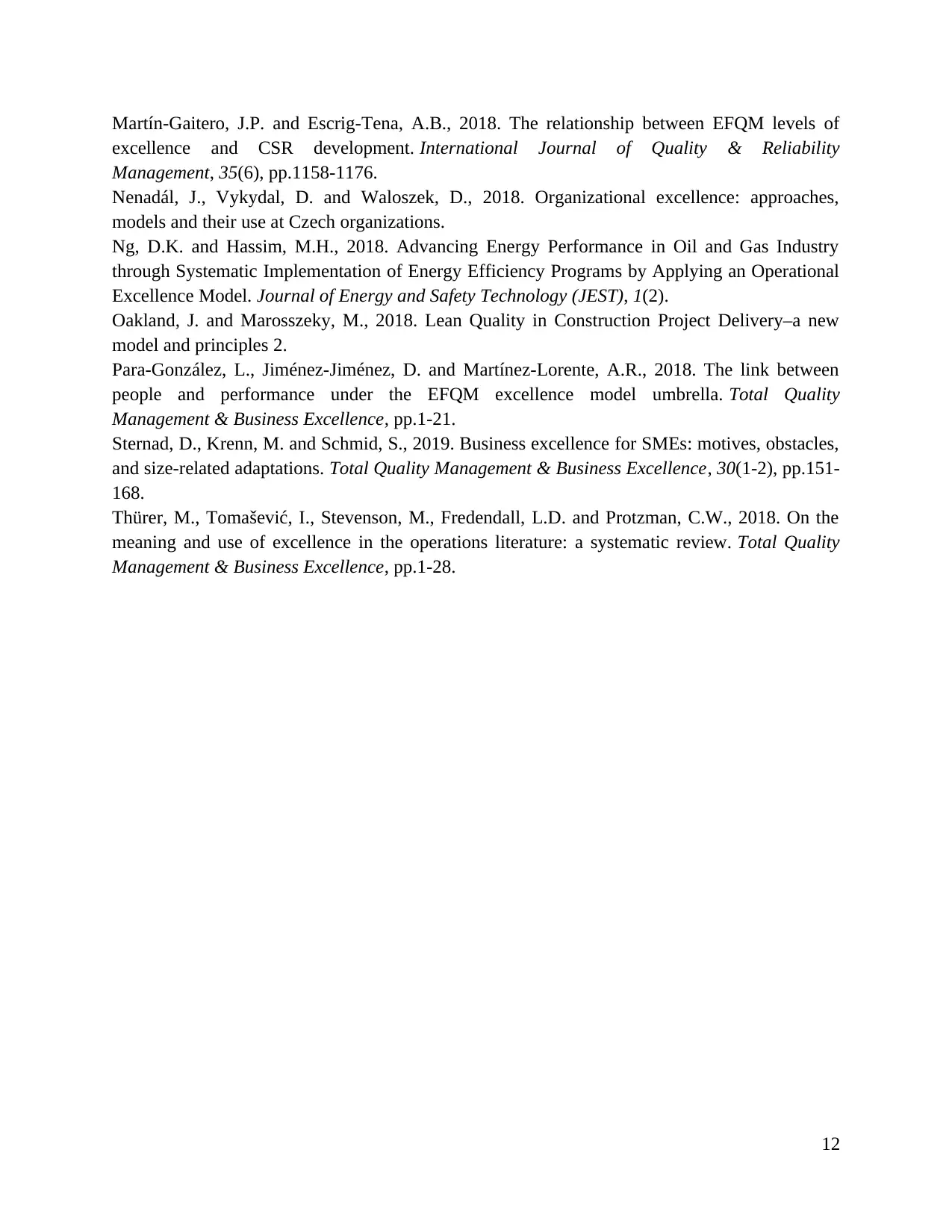
Martín-Gaitero, J.P. and Escrig-Tena, A.B., 2018. The relationship between EFQM levels of
excellence and CSR development. International Journal of Quality & Reliability
Management, 35(6), pp.1158-1176.
Nenadál, J., Vykydal, D. and Waloszek, D., 2018. Organizational excellence: approaches,
models and their use at Czech organizations.
Ng, D.K. and Hassim, M.H., 2018. Advancing Energy Performance in Oil and Gas Industry
through Systematic Implementation of Energy Efficiency Programs by Applying an Operational
Excellence Model. Journal of Energy and Safety Technology (JEST), 1(2).
Oakland, J. and Marosszeky, M., 2018. Lean Quality in Construction Project Delivery–a new
model and principles 2.
Para-González, L., Jiménez-Jiménez, D. and Martínez-Lorente, A.R., 2018. The link between
people and performance under the EFQM excellence model umbrella. Total Quality
Management & Business Excellence, pp.1-21.
Sternad, D., Krenn, M. and Schmid, S., 2019. Business excellence for SMEs: motives, obstacles,
and size-related adaptations. Total Quality Management & Business Excellence, 30(1-2), pp.151-
168.
Thürer, M., Tomašević, I., Stevenson, M., Fredendall, L.D. and Protzman, C.W., 2018. On the
meaning and use of excellence in the operations literature: a systematic review. Total Quality
Management & Business Excellence, pp.1-28.
12
excellence and CSR development. International Journal of Quality & Reliability
Management, 35(6), pp.1158-1176.
Nenadál, J., Vykydal, D. and Waloszek, D., 2018. Organizational excellence: approaches,
models and their use at Czech organizations.
Ng, D.K. and Hassim, M.H., 2018. Advancing Energy Performance in Oil and Gas Industry
through Systematic Implementation of Energy Efficiency Programs by Applying an Operational
Excellence Model. Journal of Energy and Safety Technology (JEST), 1(2).
Oakland, J. and Marosszeky, M., 2018. Lean Quality in Construction Project Delivery–a new
model and principles 2.
Para-González, L., Jiménez-Jiménez, D. and Martínez-Lorente, A.R., 2018. The link between
people and performance under the EFQM excellence model umbrella. Total Quality
Management & Business Excellence, pp.1-21.
Sternad, D., Krenn, M. and Schmid, S., 2019. Business excellence for SMEs: motives, obstacles,
and size-related adaptations. Total Quality Management & Business Excellence, 30(1-2), pp.151-
168.
Thürer, M., Tomašević, I., Stevenson, M., Fredendall, L.D. and Protzman, C.W., 2018. On the
meaning and use of excellence in the operations literature: a systematic review. Total Quality
Management & Business Excellence, pp.1-28.
12
⊘ This is a preview!⊘
Do you want full access?
Subscribe today to unlock all pages.

Trusted by 1+ million students worldwide
1 out of 12
Related Documents
Your All-in-One AI-Powered Toolkit for Academic Success.
+13062052269
info@desklib.com
Available 24*7 on WhatsApp / Email
![[object Object]](/_next/static/media/star-bottom.7253800d.svg)
Unlock your academic potential
Copyright © 2020–2025 A2Z Services. All Rights Reserved. Developed and managed by ZUCOL.





